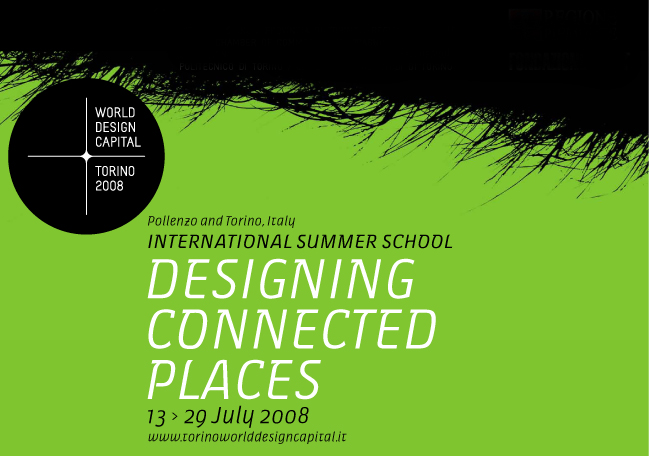검색결과 리스트
summerschool에 해당되는 글 2건
- 2008.06.26 WDC Seoul Membership Orientation
- 2008.06.26 [2008] TORINO International summer design school
글
WDC Seoul Membership Orientation
윤교수님의 추천을 받아 서울시에서 지원하는 토리노 섬머스쿨 워크샵에 참가 신청을 했었고, 운 좋게도 최종 참가자로 선정되었습니다.
이 워크샵 참가 지원은 2010년 서울 디자인 수도 홍보 사업의 일환으로 2008년 디자인수도 시범도시인 토리노에서 개최되는 워크샵 참가후에도 '2010 세계디자인수도 서울 홍보단'이라는 이름하에 보고, 전시, 홍보 등의 활동도 하게 된다네요.
24일에는 처음으로 서울시청에서 오리엔테이션 및 관계분들과의 만남을 가졌습니다.
함께 가는 분들은 총 10분 (그리고 지도 교수님 2분)으로 석사, 학사 3-4학년으로 구성되었으며
제가 속한 'COMPLEXITY MAPS' 부문에는 서지민, 김하나, 김용님께서 함께 가십니다.
'프로젝트 > 2009 TORINO workshop' 카테고리의 다른 글
| Christian Nold (1) | 2008.07.08 |
|---|---|
| Complexity Maps 3. Thomas Laureyssens - Pedestrian Levitation (0) | 2008.06.29 |
| Complexity Maps 2. Mark Lombardi - World finance corpotation and associates (0) | 2008.06.29 |
| Complexity Maps 1. They Rule (0) | 2008.06.29 |
| [2008] TORINO International summer design school (0) | 2008.06.26 |
설정
트랙백
댓글
글
[2008] TORINO International summer design school

PROJECT DESCRIPTION
Designing Connected Places is an international summer design school. But there is much more. It is also a programme for action throughout Piemonte. Using the tools of design, solutions will be outlined for 6 problems expressed by 6 local bodies. These are: health and well-being, food and new food networks, urban mobility, security and quality of life in the city, new production systems, and forms of representation of the region and its communities.
The summer school brings out a new definition of the "local" and a new role of design:
a connected local, understood as local in the era of networks and high connectivity, understood as a concept able to promote original development strategies.
A selected group of young designers of different nationalities will be called on to participate. Guided and stimulated by project leaders and visiting professors of great and proven international experience, they will work intensely for a week on themes indicated by local "clients" and prepared by meta-design work conducted by a group of researchers from various design schools.
Designing Connected Places is:
- 6 themed workshops at Pollenzo
- 1 design studio in Torino
- 6 meetings with international visiting professors (open to the public)
PROJECT PROCESS and DETAILS
Designing Connected Places is an exercise of concept generation organised in 6 workshops of one week each and which involves an international group of young designers and project leaders.
Its result will be an ample set of design ideas that propose practical solutions to well-defined problems and that, at the same time and as a whole, give a vision of the potential of design for local development.
The concept generation exercise is made more effective by the support of appropriate activities of preparation and post-production of the results: analytical and planning work - the "meta-design" - conducted before and after the concept generation workshops by a team of researchers from Italian design schools
6 WORKSHOPS LIST
The workshop is an original form of intervention in the metropolitan and regional area.
Six specific themes significant for Piemonte branch out from the general topic of "Design for local development":
- health
- mobility
- security
- food networks
- the representation of complex phenomena
- distributed production systems
The summer school stimulates the use of knowledge and competencies typical of contemporary design to enhance social and territorial resources, to solve specific problems in Piemonte, and to promote an approach oriented towards environmental sustainability.
COMPLEXITY MAPS
Design for the representation of places and communities
July 22 > 29 - Pollenzo, Italy
Background
Torino is a city on the move. The tradition forms of representation are obsolete or inadequate to depict the current reality and the dynamics in progress.
Project question
How can the city be made legible and comprehensible, understood as a complex organism and as a web of physical and social networks?
Workshop leader : Christian Nold, designer
Local team leader : Paolo Ciuccarelli
Commitment : Urban Center Metropolitano - Torino
Description
The urban territory is a system whose complexity is growing, in which a multitude of tangible and intangible flows (people, goods, information) stratify and interconnect.
Faced with all this, the traditional modes of mapping and representing the city appear entirely inadequate: the representations of the new physical and social networks, like that of their individual and collective life, are a new challenge for the design of communication. The representation of the phenomena demands the gradual abandonment of classical visual languages, i.e. of maps that lay their trust chiefly in the topological and geographical metaphor.
Overcoming these limits means building a new representation of the city: a collective vision capable of defining and visualising the new concept of urban space and, more in general, social spaces.
The theme, proposed in collaboration with the Urban Center Metropolitano of Torino, aims to produce visualisations in the form of diagrams and maps of relationships that induce a new way of viewing human-city interaction, and also useful for outlining new criteria for its development.
'프로젝트 > 2009 TORINO workshop' 카테고리의 다른 글
| Christian Nold (1) | 2008.07.08 |
|---|---|
| Complexity Maps 3. Thomas Laureyssens - Pedestrian Levitation (0) | 2008.06.29 |
| Complexity Maps 2. Mark Lombardi - World finance corpotation and associates (0) | 2008.06.29 |
| Complexity Maps 1. They Rule (0) | 2008.06.29 |
| WDC Seoul Membership Orientation (0) | 2008.06.26 |

RECENT COMMENT